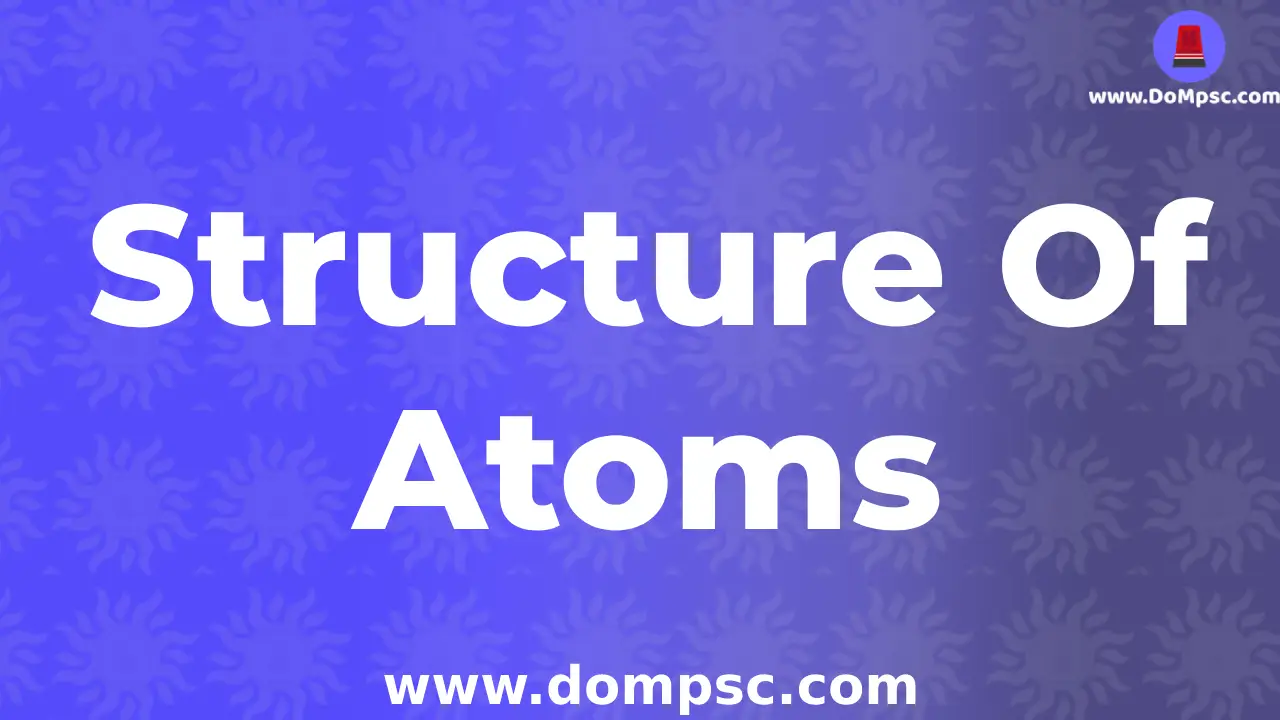Structure Of Atom(अणु ची रचना)

✪ Download pdf Works Properly on chrome Browser ✪
Structure Of Atom(अणु ची रचना)
Table Of Contain-Mpsc Structure Of Atom(अणु ची रचना)
Intro of Structure Of Atom

By Shubham Vyawahare
15-April-2025
➤Atom is the smallest particle of a any substances which can divide further.
➤ smallest unit into which matter can be divided without the release of electrically charged particles
➤The Greek root of atom is atomos, which means "indivisible.
➤Atoms are visible in telescope.
➤Atoms has charged particle.
➤Atoms are bind with intermolecular force.
.
✪ Concept of Atom by saint Kanada ✪
➤ Kanada (कणाद महर्षि ) (also known as Kashyapa and Kanabhuk) is an ancient Indian natural scientist and philosopher who founded the Vaisheshika school of Indian philosophy, which also represents the earliest physics in India.
➤ lived sometime between 6th century to 2nd century BCE.
➤ Born in Gujrat.
➤ He said that each substance is made up of a smallest particle that is Parmanu(परमाणु).
➤ He said that every superhuman has specific attributes, which are the same as the material category it belongs to.
➤ his peculiar property has made to be called vaisesika sutra.
➤Paramanu or atom belonging to different classes of substance could also combine in large numbers., “because of the peculiarily or speciality of paramanu all things seen in the world are formed” he said..
✪ Concept of Atom by Dalton ✪
➤ He Present his theory in 1803.
➤ He Said that are the substances are maid up of small small particles.
➤Atom Can not be created or not be divide.
✪ Concept of Atom by Thomson ✪
➤The plum pudding model is one of several historical scientific models of the atom. First proposed by J. J. Thomson in 1904.
➤ This model attempts to explain the two properties of atoms known at the time: electrons are negatively charged particles, and atoms have no net charge.
➤ He refer a body of a atom as a watermelon.
➤ Rewarded by a Nobel price in 1906. ➤ He assumed that the positive charges are everywhere in atom and negative charges are stick it on.
✪ Concept of Atom by Rutherford ✪
➤The Rutherford model was designed by Ernest Rutherford, a physicist born in New Zealand, to describe atoms.
➤ Rutherford directed the Geiger-Marsden experiment in 1909. According to Rutherford's (1911) analysis, J. J. Thomson's plum pudding model was incorrect.
➤ Non-metals exhibit very low conductivity. Low or non-existent conductivity is the most important characteristic to distinguish non-metals from metals..
➤ Rutherford Gold Experiment- A piece of gold foil was hit by positively charged alpha particles. Most of the alpha particles passed. This shows that gold atoms are mostly empty spaces. The paths of some particles bend into large angles. A few even bounced back. The only way this can happen is if there is a small, heavier positively charged region inside the atom.
➤He said that the atom charge is placed at a center which is known as nucleus and this is postive charged particle and negative charge particle revolve around center in particular circular path.
✪Concept of atom by Bohr✪
➤ In 1913, Niels Bohr (Niels Bohr) proposed a hydrogen atom theory based on quantum theory, that is, energy is only transferred in certain clearly defined amounts.
➤ He said that atom's electron are moved in particular path.
➤ Electron cant change there Orbit generally.
➤ To change Orbit electron has to either absorb energy or release energy.
➤ When jumping from one orbit to another with lower energy, a light quantum is emitted..
➤ Bohr's theory could explain why atoms emitted light in fixed wavelengths.
✪ Structure Of Atom ✪
➤ On basis of all scientist research.
➤ The world come so some particular point about atom.
➤ The followings are the properties of atom.
➤ Atom has nucleus in the center.
➤ Atom has hollow space around his structure where electron moves.
➤At center of atom neutrons and nucleons are rotate.
➤ Atom has same number of protons and neutrons but Electrons are not in same number
➤ Atom consist of proton(+) electron(-) and neutron(Charge less )
Proton
➤Protons have slightly less mass than the neutrons in the nucleus.
➤The actual mass of the proton is 1.6726 x 10^-27 kilograms, which is a very small mass indeed.
➤ The positive charge of a proton is one (+1) and its mass is 1 atomic mass unit (amu)..
➤ Proton are positive charged particles.
Electron
➤Negative charge particle.
➤Revolve around nucleus in circular orbit.
➤Charge - 1.6726 x 10^-27.
Neutron
➤Charge-less particle
➤ Found in center of atom.
➤The number of neutrons are same as protons in atom.
Atomic Number
➤ The total number of protons or electrons present in the nucleus of every atom.
➤ It is denoted by Z.
➤ Eg Atomic number of carbon is 6 that means it has 6 protons.
Atomic Mass Number
➤Atomic mass number is weight of protons and neutrons.
➤Atomic mass is the total mass of particle present in the atom.
➤Electrons weight cant consider because of its low weight which is negligible.
➤Electron left the atom because or its low weight so it can freely move.
➤Atomic mass number is denoted by (A).
➤Atomic mass number is denoted by (A) which is measured in Dalton unit and 1 dalton is 1.6726 x 10^-27kg .
✪ How atomic number and atomic mass number should write ✪
➤ Atomic mass number at top side and atomic number rewritten at base of substance symbol.
eg. Suppose carbon has 6 ATOMIC NUMBER and 12 atomic mass number so it should be written as 126C.
➤That means carbon has Atomic number (z)=6 and atomic mass number(A)=12.
Electronic Configuration
➤Electronic configuration is the distribution of electrons in atoms or molecules in atomic or molecular orbitals.
➤ Electrons are revolve around particular path.
➤ There are difference in orbit means there is difference in force of attraction.
➤ So On the basis of force of attraction and electron weight they revolve around particular path.
➤ the Orbits are names As K,L,M,N.
➤ And the number of electron present in the each orbit can be calculate on the basis of (2n)2formula.
➤ Example with (2n)2
➤ Sodium has 11 electrons.
➤ As per the (2n)2=electrons in first orbit is (2*1)2=1
➤ Similarly In second orbit (2*2)2=8
➤ Like wise we can calculate electrons and each orbit and this electronic configuration of atom.
➤Eg.This is written as 2,8,3
Valency
➤This is the capacity of atom to release his electron.
➤ Atom perform the process of acceptance of electron or donate a electron to get into a stable state.
➤ Suppose any itom has (2,8,1) So he can donate last electron to establish stable state.
➤ This shows that this atom can donate 1 electron so valency of this metal is 1.
➤ Some time substance get stable state by accepting electron.
➤ Electronic configuration of sodium is (2,8,1) so he denote 1 electron so sodium can be written as NA+
➤ Similarly Electronic configuration of chlorine is (2,8,7) so he can accept 1 electron.
➤ so this is written as Cl-.
✪ Isotopes ✪
Q. What is Isotopes in chemistry ?
➤ Substances are found in various structure in nature.
➤ Sometimes same substance has various weight thats atomic mass in nature.
➤ Atomic number is substance has same in atomic number but difference in atomic mass number.
➤ That means neutrons are different i number.
➤ Eg. carbon and Carbon-14
➤ 126C this is normal carbon and 146C this is carbon-14.
➤ Both has difference in atomic mass number but they has same atomic number.So they are Isotopes of each Other.
✪ Isobars ✪
Q. What is Isobars in chemistry ?
➤ Isobars means pair of substances which has same number of atomic mass number but difference in atomic number.
➤ They same number of protons.
➤ Eg. Potassium-40 and calcium-40
Others Blogs Related to MPSC Chemistry Notes
Read All MPSC blogs
- ➤केंद्र सरकारने खाजगी क्लासेस साठी नवी नियमावली लागू केली आहे |GUIDELINES FOR REGULATION OF COACHING CENTER in marathi
- ➤MPSC Data leak: पेपर न फुटल्याचा दावा MPSC आयोगाने स्पष्टपणे केला आहे
- ➤MPSC hall ticket data leaked before 6 days of exam
- ➤MPSC Data leak: टेलेग्राम वर अचानक ९० हजार परीक्षार्थींचे प्रवेशपत्र झाले लिक
- ➤मराठी भाषेला अभिजात दर्जा मिळायला हवाच , अभिजात दर्जा नेमका कसा मिळतो ?
Download MPSC Books pdf



